03 Mar 2023
Tilmann Galler, Global Market Strategist
"While a correction in house prices seems unavoidable, one of the key variables that will define the magnitude of the downturn is the success of central banks in containing inflation."
Housing markets have boomed in recent years since the trough of the Global Financial Crisis (GFC), with buyers taking advantage of record low borrowing costs. Since then, however, central banks have had to push borrowing costs materially higher in a bid to see off soaring inflation. The question now is whether this environment of higher interest rates will prompt a new housing crash and a wider economic crisis.
We believe that house prices are indeed due for a correction, which would have adverse implications for growth. However, there are several mitigating factors compared to the last crisis. Housing supply is low, maturities of average mortgages are longer, and labour markets are tight. Most importantly, banks’ balance sheets are much stronger than before the financial crisis, making them less vulnerable to an economic downturn.
Central banks are throwing cold water on a hot housing market
Central banks’ determination to bring inflation back to their targets has altered the fundamentals of the real estate market. The US, UK and eurozone all saw their fastest hiking cycles in more than 30 years, resulting in sovereign bond yields rising sharply across the board. Hence, mortgage rates have more than doubled from post-pandemic lows in the US and tripled in most European countries. Given the sharp rise in house prices over the past seven years (Exhibit 1), the surge in interest rates has depressed home affordability to the lowest level since the eve of the last housing crisis in 2006. In 2022, housing transactions fell sharply and house price data in the second half of the year had already started to signal a softening of the pricing environment in North America and Europe.
Exhibit 1: Nominal house prices
Index level, rebased to 100 in 2015

Source: OECD, J.P. Morgan Asset Management. Data as of 31 December 2022.
Housing market vulnerabilities
From the lows of the financial crisis, global nominal house prices increased by 75%, pushing the housing market in overvalued territory in North America and most European countries. Growth in disposable income hasn’t been able to keep up over the same period. That’s why many large developed economies currently have house price to disposable income ratios close to, or at historical highs (Exhibit 2). This leaves today’s housing markets significantly more vulnerable to higher interest rates and financing costs. Overvaluation is not evenly spread, however. Japan, Italy and Spain are the only G20 developed market countries with ratios below their historical averages.
Exhibit 2: Ratio of house prices to personal disposable income
Ratio of nominal price indices rebased to 100 in 2005
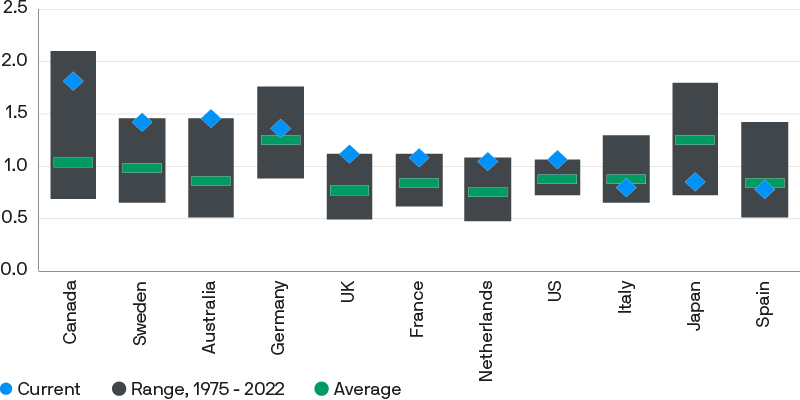
Source: Federal Reserve Bank of Dallas, J.P. Morgan Asset Management. Data as of 31 January 2023.
The relevance of the price to disposable income metric for the housing market outlook can be compared to price to earnings ratios for equites. In the short term, it has little relevance but valuations do matter for long-term performance. For example, the US experienced only two periods of major nominal house price declines in the past 50 years. Both periods occurred after the price to disposable income indicator shot above 1.0. In both cases, significant monetary tightening and a sharp rise in unemployment were required to cool house price exuberance. In Q3 2022, this indicator stood at 1.06 – a historical high (Exhibit 3).
Exhibit 3: US house price index vs house price to personal disposable income ratio*
% change year on year (LHS); ratio (RHS)
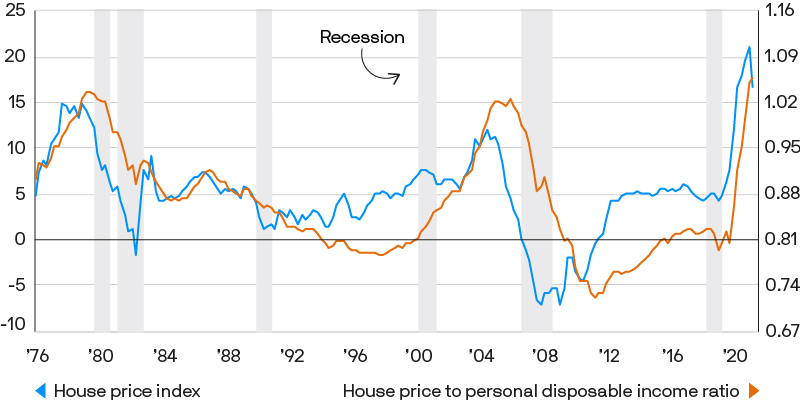
Source: Federal Reserve Bank of Dallas, J.P. Morgan Asset Management. Periods of “recession” are defined using US National Bureau of Economic Research (NBER) business cycle dates.
* House price index and personal disposable income index are rebased to 100 in 2005. Personal disposable income reported in per capita terms. Data as of 31 January 2023.
Since the beginning of 2022, interest rates on new mortgages increased considerably. In the US, annual 30-year mortgage costs for new homes doubled to 50% of household median income, while European mortgage rates tripled on average. Home affordability today is at a multi-year low. Housing transactions are falling sharply since a decreasing number of households can afford to purchase a house (Exhibit 4). However, evidence from the 1980s shows that even in phases of high financing costs, transactions in residential real estate never come to a complete standstill, since affluent households can reduce ongoing financing costs through taking a higher share of equity. Therefore, prime locations are more resilient in periods of housing weakness.
Exhibit 4: US mortgage cost vs single-family home sales
Mortgage payments as a % of median income (LHS); thousands (RHS)
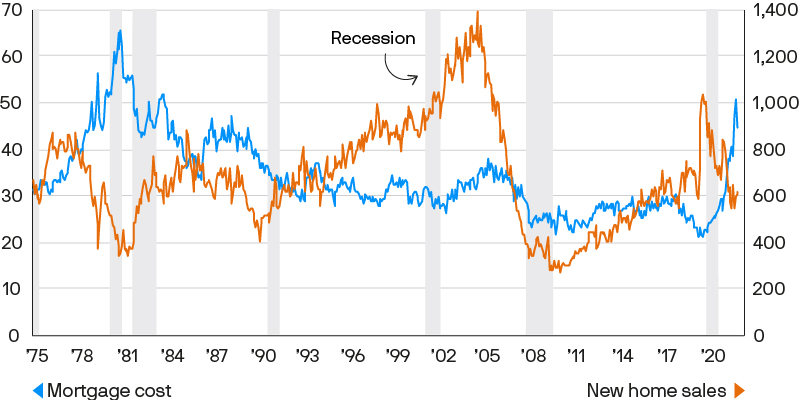
Source: Bloomberg, Census Bureau, J.P. Morgan Asset Management. Periods of “recession” are defined using US National Bureau of Economic Research (NBER) business cycle dates. Single-family home sales are seasonally adjusted and annualized. Data as of 24 February 2023.
Moderate investment activity in this housing cycle has resulted in relatively low inventories, which is fundamentally different to the situation in 2006 where there was a big supply overhang in the US due to excessive building activity. The rental vacancy rate of 5.8% at the end of 2022 was significantly below the long-term average 7.3%. The lack of supply should mitigate the extent of the house price correction in the near term and turn into a tailwind as soon as interest rates and financing cost moderate.
For housing markets to find their balance, affordability needs to normalise. This can happen in three ways:
In our view there is a good chance that all three variables will contribute to improve affordability. As we pointed out in our 2023 investment outlook: A bad year for the economy, a better year for markets, slowing economic activity in the West and diminishing supply chain disruptions should ease inflation through the course of 2023. This gives central banks the opportunity to pause and finally lower rates as inflation moves closer to target in 2024, helping to shorten the adjustment period in the housing market. As a reference, the three real house price corrections in the US over the past 50 years lasted between 2.5 and 5.5 years.
Impact on real economy and consumer
A downturn in housing can affect GDP growth in three ways: Reduced contribution from the construction sector, a squeeze on consumption, and the threat of a financial crisis.
A fall in transactions and less demand for houses have a direct impact on the value add in construction and related activities. At the peak of the housing boom in 2006, eurozone gross fixed capital formation in dwellings was 7% of GDP and fell to 4.8% of GDP at the post GFC trough in 2015. While construction sector weakness might contribute to weaker future growth, the sector is not big enough in North America and Europe to push the local economies into recession.
Much more relevant is the impact on consumption, which is 68% of GDP in the US and 52% of GDP in Europe. Consumption can be negatively affected in two ways. Rising mortgage costs can eat into households' discretionary spending. The size of the impact varies from country to country, depending on the time it takes higher interest rates to pass through to homeowners. This is dependent on the proportion of equity in home ownership as well as the average maturity of mortgages. Italy and Germany look less vulnerable in that respect compared to Sweden, the UK and Spain. In the US, the share of variable rate mortgages shrunk from over 20% in 2006 to below 5% in 2022 and 30 year mortgages are now the most commonly used. However, the overall leverage in house ownership is relatively high (Exhibit 5).
Exhibit 5: Home ownership by mortgage status
% of households
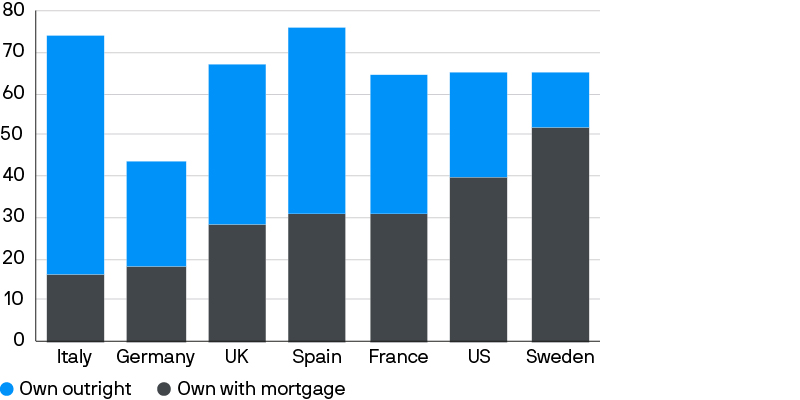
Source: Eurostat, OECD, J.P. Morgan Asset Management. Data as of 31 January 2022.
House price declines can also negatively impact consumption through the wealth effect as homes represent 29% of overall assets in the US. If unemployment doesn’t rise significantly, the wealth effect may only be limited as households, in the absence of the threat of financial distress, have less incentive to ramp up their savings. However, previous US consumer-led recessions in the early 1980s, 1990/91 and 2008 were accompanied by sharp rises in unemployment.
Low housing affordability and high new mortgage costs can also have a negative effect on labour mobility. This amplifies the labour shortage in the US and Europe and dampen growth.
The biggest risk of a housing downturn is that it morphs into a financial crisis. Compared to 2006, banks are much better capitalised and credit quality is much higher (Exhibit 6). The US subprime market was 25% of overall mortgage origination in the years leading to the GFC, while today it is less than 8%. While an increase in delinquencies is a likely consequence of a housing downturn, the risks to the banking sector look more idiosyncratic than systemic. However, a pronounced downturn might force banks to tighten lending even further which could have negative repercussions for overall economic activity.
Exhibit 6: Core tier 1 capital ratios
%, regulatory tier 1 capital to risk-weighted assets
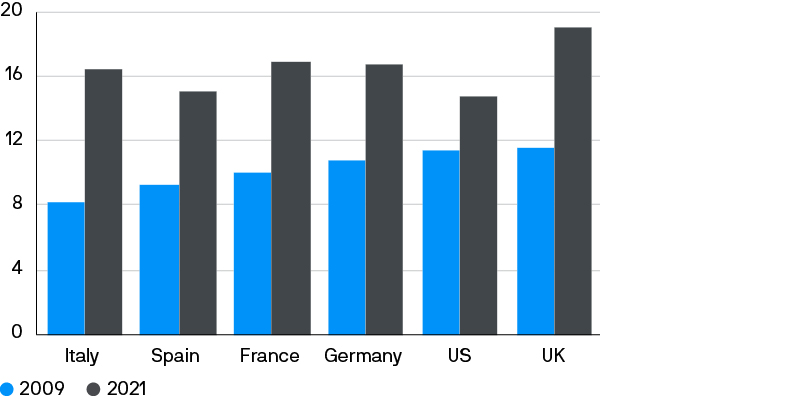
Source: IMF, Refinitiv Datastream, J.P. Morgan Asset Management. Core tier 1 ratios are a measure of banks' financial strength, comparing core tier 1 capital (equity capital and disclosed reserves) against total risk-weighted assets. Guide to the Markets – Europe. Data as of 31 December 2022.
Conclusion
The housing sector is currently very vulnerable to a downturn due to high valuations, rising interest rates and low affordability. Risks are unevenly spread globally due to diverse structures and the characteristics of local markets.
While a correction in house prices seems unavoidable, one of the key variables that will define the magnitude of the downturn is the success of central banks in containing inflation. Our base case scenario is that central banks will be able to at least pause tightening, with inflationary pressures easing, and return to a more accommodative stance in following years, limiting the downside in the housing market.
If inflation was to remain stubbornly high, hawkish central bank policy may accelerate house price declines. Rising mortgage costs cutting into discretionary income and negative wealth effect will depress consumer spending further, which could finally lead to a recession in Europe and the US. Nevertheless, even in an inflationary scenario, we are unlikely to enter a vicious cycle due to low inventories, better quality lending and stronger bank capitalisation.
The Market Insights programme provides comprehensive data and commentary on global markets without reference to products. Designed as a tool to help clients understand the markets and support investment decision-making, the programme explores the implications of current economic data and changing market conditions. For the purposes of MiFID II, the JPM Market Insights and Portfolio Insights programmes are marketing communications and are not in scope for any MiFID II / MiFIR requirements specifically related to investment research. Furthermore, the J.P. Morgan Asset Management Market Insights and Portfolio Insights programmes, as non-independent research, have not been prepared in accordance with legal requirements designed to promote the independence of investment research, nor are they subject to any prohibition on dealing ahead of the dissemination of investment research.
This document is a general communication being provided for informational purposes only. It is educational in nature and not designed to be taken as advice or a recommendation for any specific investment product, strategy, plan feature or other purpose in any jurisdiction, nor is it a commitment from J.P. Morgan Asset Management or any of its subsidiaries to participate in any of the transactions mentioned herein. Any examples used are generic, hypothetical and for illustration purposes only. This material does not contain sufficient information to support an investment decision and it should not be relied upon by you in evaluating the merits of investing in any securities or products. In addition, users should make an independent assessment of the legal, regulatory, tax, credit, and accounting implications and determine, together with their own financial professional, if any investment mentioned herein is believed to be appropriate to their personal goals. Investors should ensure that they obtain all available relevant information before making any investment. Any forecasts, figures, opinions or investment techniques and strategies set out are for information purposes only, based on certain assumptions and current market conditions and are subject to change without prior notice. All information presented herein is considered to be accurate at the time of production, but no warranty of accuracy is given and no liability in respect of any error or omission is accepted. It should be noted that investment involves risks, the value of investments and the income from them may fluctuate in accordance with market conditions and taxation agreements and investors may not get back the full amount invested. Both past performance and yields are not a reliable indicator of current and future results. J.P. Morgan Asset Management is the brand for the asset management business of JPMorgan Chase & Co. and its affiliates worldwide. To the extent permitted by applicable law, we may record telephone calls and monitor electronic communications to comply with our legal and regulatory obligations and internal policies. Personal data will be collected, stored and processed by J.P. Morgan Asset Management in accordance with our privacy policies at https://am.jpmorgan.com/global/privacy. This communication is issued by the following entities: In the United States, by J.P. Morgan Investment Management Inc. or J.P. Morgan Alternative Asset Management, Inc., both regulated by the Securities and Exchange Commission; in Latin America, for intended recipients’ use only, by local J.P. Morgan entities, as the case may be.; in Canada, for institutional clients’ use only, by JPMorgan Asset Management (Canada) Inc., which is a registered Portfolio Manager and Exempt Market Dealer in all Canadian provinces and territories except the Yukon and is also registered as an Investment Fund Manager in British Columbia, Ontario, Quebec and Newfoundland and Labrador. In the United Kingdom, by JPMorgan Asset Management (UK) Limited, which is authorized and regulated by the Financial Conduct Authority; in other European jurisdictions, by JPMorgan Asset Management (Europe) S.à r.l. In Asia Pacific (“APAC”), by the following issuing entities and in the respective jurisdictions in which they are primarily regulated: JPMorgan Asset Management (Asia Pacific) Limited, or JPMorgan Funds (Asia) Limited, or JPMorgan Asset Management Real Assets (Asia) Limited, each of which is regulated by the Securities and Futures Commission of Hong Kong; JPMorgan Asset Management (Singapore) Limited (Co. Reg. No. 197601586K), this advertisement or publication has not been reviewed by the Monetary Authority of Singapore; JPMorgan Asset Management (Taiwan) Limited; JPMorgan Asset Management (Japan) Limited, which is a member of the Investment Trusts Association, Japan, the Japan Investment Advisers Association, Type II Financial Instruments Firms Association and the Japan Securities Dealers Association and is regulated by the Financial Services Agency (registration number “Kanto Local Finance Bureau (Financial Instruments Firm) No. 330”); in Australia, to wholesale clients only as defined in section 761A and 761G of the Corporations Act 2001 (Commonwealth), by JPMorgan Asset Management (Australia) Limited (ABN 55143832080) (AFSL 376919). For all other markets in APAC, to intended recipients only. For U.S. only: If you are a person with a disability and need additional support in viewing the material, please call us at 1-800-343-1113 for assistance.
Copyright 2023 JPMorgan Chase & Co. All rights reserved.